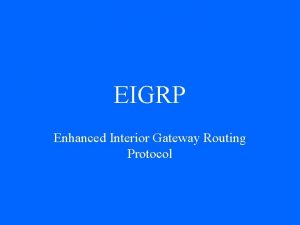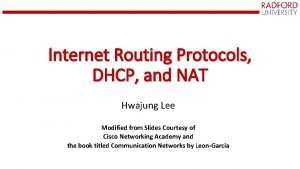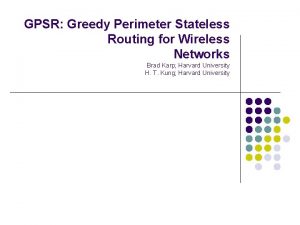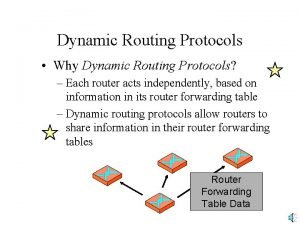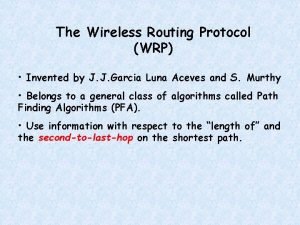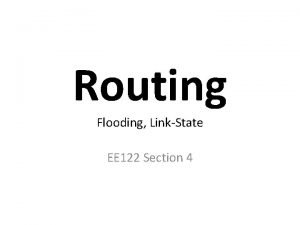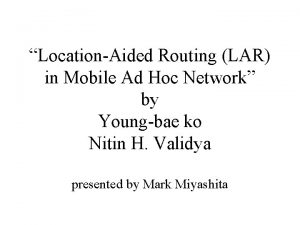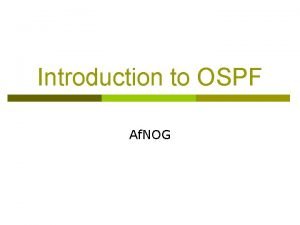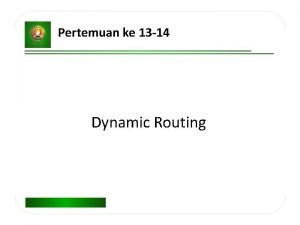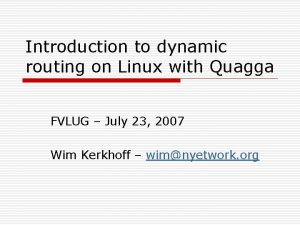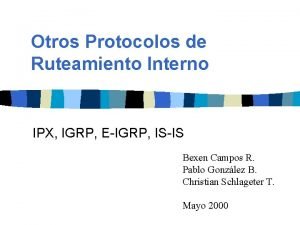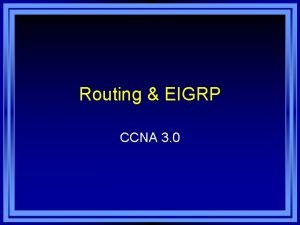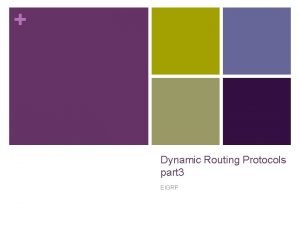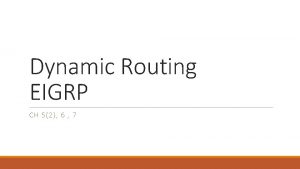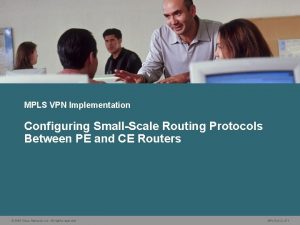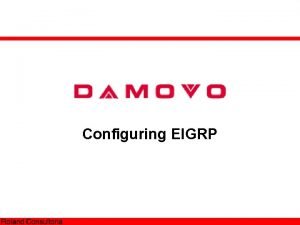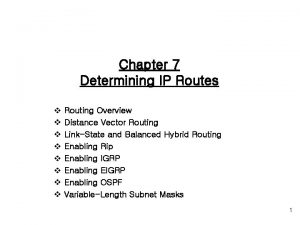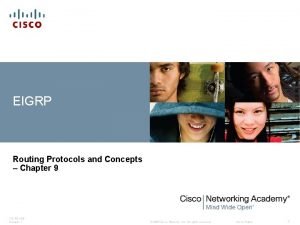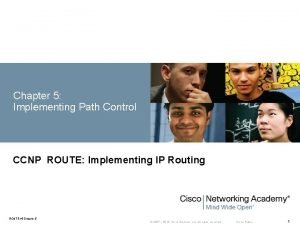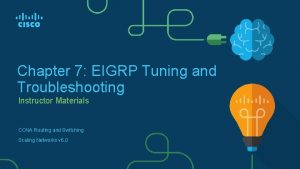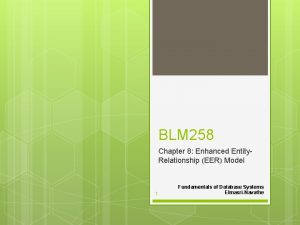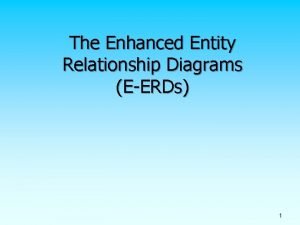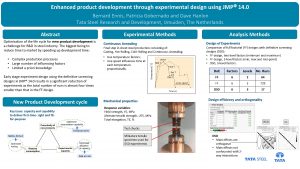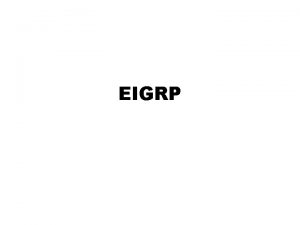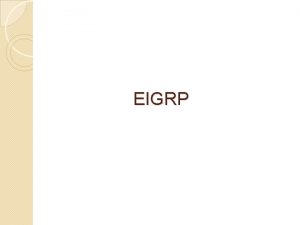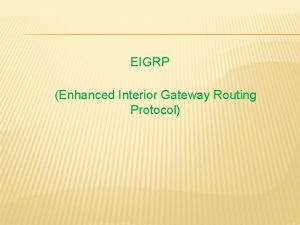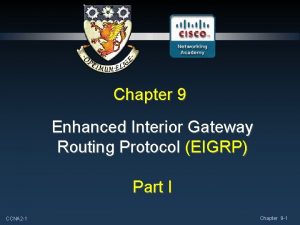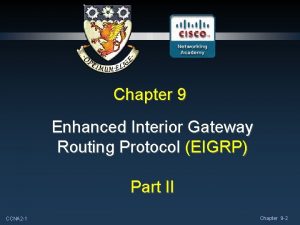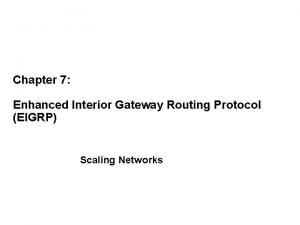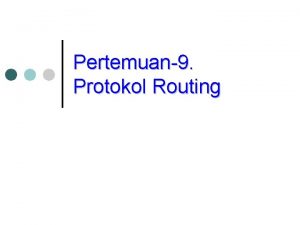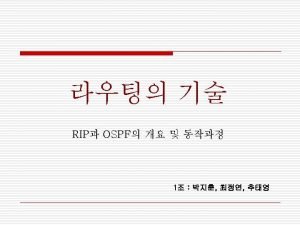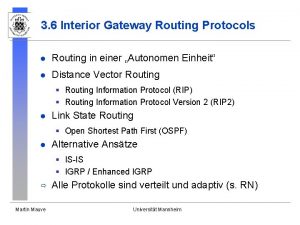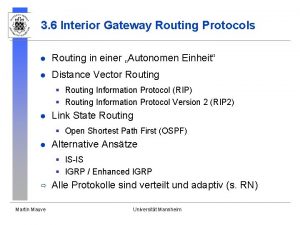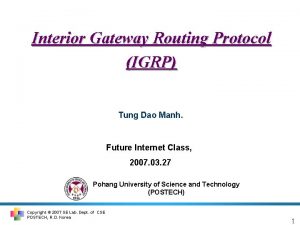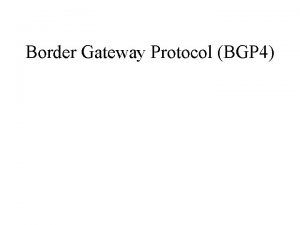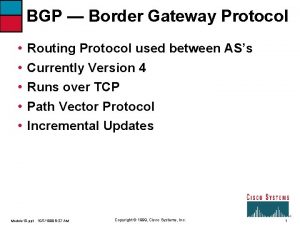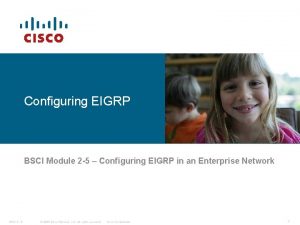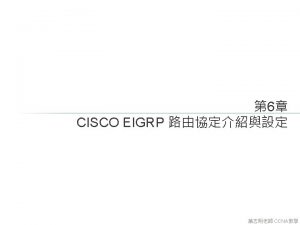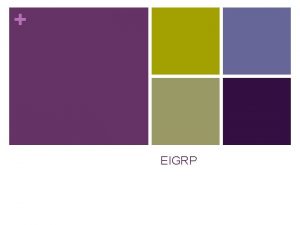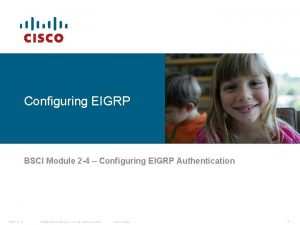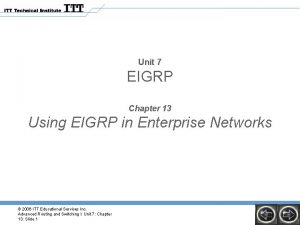Dynamic Routing Protocol EIGRP EIGRP Enhanced Interior Gateway












































- Slides: 44


Dynamic Routing Protocol EIGRP

EIGRP Enhanced Interior Gateway Routing Protocol (EIGRP) is an advanced distance vector routing protocol developed by Cisco Systems. As the name suggests, EIGRP is an enhancement of another Cisco routing protocol IGRP (classful) EIGRP is a distance vector routing protocol that includes features found in link-state routing protocols. EIGRP is suited for many different topologies and media. EIGRP provide extremely quick convergence times with minimal network traffic

EIGRP was originally a proprietary protocol on Cisco devices only. In 2013, EIGRP became a multi-vendor routing protocol.

EIGRP

EIGRP By default, EIGRP uses the following values in its composite metric to calculate the preferred path to a network: Bandwidth - The slowest bandwidth among all of the outgoing interfaces, along the path from source to destination. Delay - The cumulative (sum) of all interface delay along the path (in tens of microseconds). The following values can be used, but are not recommended, because they typically result in frequent recalculation of the topology table: Reliability - Represents the worst reliability between the source and destination, which is based on keepalives. Load - Represents the worst load on a link between the source and destination, which is computed based on the packet rate and the configured bandwidth of the interface.

EIGRP

EIGRP Bandwidth Calculations EIGRP uses the slowest bandwidth in its metric calculation. The slowest bandwidth can be determined by examining each interface between R 2 and the destination network 192. 168. 1. 0. The Serial 0/0/1 interface on R 2 has a bandwidth of 1, 024 kb/s. The Gigabit. Ethernet 0/0 interface on R 3 has a bandwidth of 1, 000 kb/s. Therefore, the slowest bandwidth is 1, 024 kb/s and is used in the calculation of the metric. EIGRP divides a reference bandwidth value of 10, 000 by the interface bandwidth value in kb/s. This results in higher bandwidth values receiving a lower metric and lower bandwidth values receiving a higher metric. 10, 000 is divided by 1, 024. If the result is not a whole number, then the value is rounded down. In this case, 10, 000 divided by 1, 024 equals 9, 765. 625. The. 625 is dropped to yield 9, 765 for the bandwidth portion of the composite metric.

EIGRP Delay. Calculations

EIGRP Metric Calculations

EIGRP Metric Calculations

EIGRP Metric Calculations

EIGRP includes features of both link-state and distance vector routing protocols. However, EIGRP is still based on the key distance vector routing protocol principle, in which information about the rest of the network is learned from directly connected neighbors. EIGRP is an advanced distance vector routing protocol that includes features not found in other distance vector routing protocols like RIP and IGRP

EIGRP Diffusing Update Algorithm As the computational engine that drives EIGRP, the Diffusing Update Algorithm (DUAL) resides at the center of the routing protocol. DUAL guarantees loop-free and backup paths throughout the routing domain. Using DUAL, EIGRP stores all available backup routes for destinations so that it can quickly adapt to alternate routes when necessary.

EIGRP Partial and Bounded Updates EIGRP uses the terms, partial and bounded, when referring to its updates. Unlike RIP, EIGRP does not send periodic updates and route entries do not age out. The term partial means that the update only includes information about the route changes, such as a new link or a link becoming unavailable. The term bounded refers to the propagation of partial updates that are sent only to those routers that the changes affect. This minimizes the bandwidth that is required to send EIGRP updates.

EIGRP

EIGRP RIP V 2, OSPF, and EIGRP can be configured to Authenticate their routing information.

EIGRP 5 packets types are used in EIGRP

EIGRP multicast address for IPv 4 is 224. 0. 0. 10. EIGRP multicast address for IPv 6 is FF 02: : A.

EIGRP

EIGRP R 2 lost network connectivity. Therefore a query is sent to the other Routers asking for alternative routes to that LAN

EIGRP

EIGRP

EIGRP

EIGRP

EIGRP

EIGRP

EIGRP Configuring EIGRP Router eigrp “autonomous-system number” To remove EIGRP Protocol Router eigrp “autonomous-system number” The AS number helps to keep the routers inform of where They should send updates. More than one Instance of EIGRP may be running on a router AS number range from 1 and 65, 535

EIGRP

EIGRP Cisco routers derive the router ID based on three criteria, in the following precedence: 1. Use the IPv 4 address configured with the eigrp router-id router configuration mode command. 2. If the router ID is not configured, the router chooses the highest IPv 4 address of any of its loopback interfaces. 3. If no loopback interfaces are configured, the router chooses the highest active IPv 4 address of any of its physical interfaces IPv 4 uses the 32 -bit router ID to identify the originating router for redistribution of external routes.

EIGRP

EIGRP

EIGRP Passive Interface The passive-interface router configuration mode command disables the transmission and receipt of EIGRP Hello packets on these interfaces. Router(config)# router eigrp as-number Router(config-router)# passive-interface-type interface-number

EIGRP


EIGRP

EIGRP Operation of EIGRP DUAL and the Topology Table EIGRP uses the Diffusing Update Algorithm (DUAL) to provide the best loop-free path and loop-free backup paths. DUAL uses several terms, which are discussed in more detail throughout this section: Successor Feasible Distance (FD) Feasible Successor (FS) Reported Distance (RD) or Advertised Distance (AD) Feasible Condition or Feasibility Condition (FC) These terms and concepts are at the center of the loop avoidance mechanism of DUAL. show ip eigrp topology

EIGRP

EIGRP

EIGRP

EIGRP

EIGRP

EIGRP

 How eigrp works
How eigrp works Mark tinka
Mark tinka Difference between clock routing and power routing
Difference between clock routing and power routing Level pool routing
Level pool routing Hydrologic routing and hydraulic routing
Hydrologic routing and hydraulic routing Dhcp routing protocol
Dhcp routing protocol Tora routing protocol
Tora routing protocol Gpsr routing protocol
Gpsr routing protocol Ospf routing protocol
Ospf routing protocol Link2be
Link2be Link state routing protocol
Link state routing protocol Lar routing protocol
Lar routing protocol Ospf routing protocol
Ospf routing protocol Difference between dynamic and static routing
Difference between dynamic and static routing Dynamic routing
Dynamic routing Introduction to dynamic routing protocols
Introduction to dynamic routing protocols Igrp configuration in packet tracer
Igrp configuration in packet tracer Linux dynamic routing
Linux dynamic routing Earth's dynamic crust and interior topic 12
Earth's dynamic crust and interior topic 12 Igrp eigrp
Igrp eigrp Eigrp ccna
Eigrp ccna Eigrp otp
Eigrp otp Appletalk
Appletalk Eigrp
Eigrp Eigrp mpls
Eigrp mpls Eigrp pdm
Eigrp pdm Debug ip eigrp
Debug ip eigrp Eigrp pdm
Eigrp pdm Sucesor factible eigrp
Sucesor factible eigrp Ccna 3 scaling networks ppt
Ccna 3 scaling networks ppt Eigrp offset-list
Eigrp offset-list Eigrp troubleshooting cheat sheet
Eigrp troubleshooting cheat sheet Dynamic dynamic - bloom
Dynamic dynamic - bloom Programa ng pamahalaan para sa mamamayan
Programa ng pamahalaan para sa mamamayan Enhanced entity-relationship
Enhanced entity-relationship Enhanced basic education act of 2013
Enhanced basic education act of 2013 Contrast enhanced mammography hologic
Contrast enhanced mammography hologic Enhanced health in care homes
Enhanced health in care homes Supertype and subtype entities examples
Supertype and subtype entities examples Enhanced product development
Enhanced product development Cisco 2960 lifetime warranty
Cisco 2960 lifetime warranty Howland current pump
Howland current pump Types of visual inspection
Types of visual inspection Enhanced oil recovery institute
Enhanced oil recovery institute Buried in barstow enhanced edition
Buried in barstow enhanced edition
